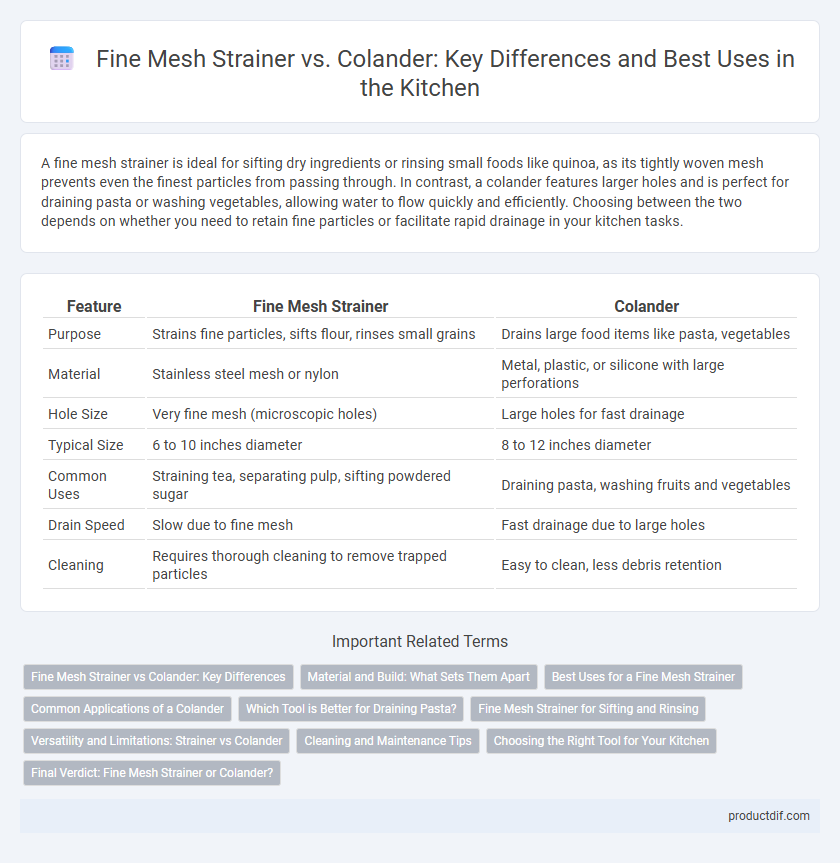A fine mesh strainer is ideal for sifting dry ingredients or rinsing small foods like quinoa, as its tightly woven mesh prevents even the finest particles from passing through. In contrast, a colander features larger holes and is perfect for draining pasta or washing vegetables, allowing water to flow quickly and efficiently. Choosing between the two depends on whether you need to retain fine particles or facilitate rapid drainage in your kitchen tasks.
Table of Comparison
| Feature | Fine Mesh Strainer | Colander |
|---|---|---|
| Purpose | Strains fine particles, sifts flour, rinses small grains | Drains large food items like pasta, vegetables |
| Material | Stainless steel mesh or nylon | Metal, plastic, or silicone with large perforations |
| Hole Size | Very fine mesh (microscopic holes) | Large holes for fast drainage |
| Typical Size | 6 to 10 inches diameter | 8 to 12 inches diameter |
| Common Uses | Straining tea, separating pulp, sifting powdered sugar | Draining pasta, washing fruits and vegetables |
| Drain Speed | Slow due to fine mesh | Fast drainage due to large holes |
| Cleaning | Requires thorough cleaning to remove trapped particles | Easy to clean, less debris retention |
Fine Mesh Strainer vs Colander: Key Differences
Fine mesh strainers feature tightly woven mesh ideal for sifting flour, rinsing grains, and straining sauces, while colanders have larger perforations suited for draining pasta and washed vegetables. The fine mesh strainer excels in separating fine particles and liquids, providing a smoother texture, whereas colanders offer quicker drainage for bulkier items. Choosing between these kitchen tools depends on the precision and type of straining or draining required during food preparation.
Material and Build: What Sets Them Apart
Fine mesh strainers are typically crafted from stainless steel with tightly woven wire mesh, allowing them to filter out tiny particles and provide durability against rust and corrosion. Colanders are generally made from perforated stainless steel, plastic, or silicone, featuring larger holes designed for rapid draining of water from pasta or vegetables. The difference in material and construction directly impacts their specific uses in kitchen tasks, with strainers emphasizing precision filtration and colanders focusing on efficient drainage.
Best Uses for a Fine Mesh Strainer
A fine mesh strainer excels in tasks requiring the separation of tiny particles from liquids, such as sifting flour, rinsing quinoa, or straining sauces to achieve a smooth consistency. Its dense weave effectively removes impurities, pulp, and small solids from stocks, broths, and juices, ensuring a refined culinary result. Unlike colanders, which are ideal for draining larger food items like pasta and vegetables, fine mesh strainers provide precision filtering for delicate preparations and fine textures.
Common Applications of a Colander
A colander is primarily used for draining large quantities of pasta, rinsing vegetables and fruits, and washing leafy greens, thanks to its larger holes and bowl shape. Its sturdy design allows it to handle hot water safely while straining food quickly and efficiently. The colander's versatility makes it a staple in kitchens for tasks that require both draining and rinsing without trapping smaller particles like seeds or grains.
Which Tool is Better for Draining Pasta?
A fine mesh strainer excels at draining pasta by preventing small noodles from slipping through its tiny holes, ensuring no loss of food during rinsing or draining. Colanders, with their larger perforations, offer quicker water drainage and are ideal for bigger pasta shapes but may allow smaller pasta or broken pieces to escape. For precision and versatility in draining various pasta types without spillage, a fine mesh strainer is the superior kitchenware choice.
Fine Mesh Strainer for Sifting and Rinsing
Fine mesh strainers excel in sifting flour, powdered sugar, and other dry ingredients, ensuring a smooth texture in baking recipes. They also effectively rinse small grains like quinoa and rice, preventing loss through the mesh while removing debris. Unlike colanders, fine mesh strainers have a tighter weave, making them ideal for filtering fine particles and liquids with greater precision.
Versatility and Limitations: Strainer vs Colander
Fine mesh strainers excel at filtering small particles from liquids, making them ideal for tasks like sifting flour, straining sauces, and rinsing grains or seeds. Colanders, typically featuring larger holes, are better suited for draining water from pasta or washing fruits and vegetables but cannot trap fine particles effectively. While strainers offer precision in separating fine elements, colanders provide greater capacity and sturdiness for heavy-duty draining.
Cleaning and Maintenance Tips
Fine mesh strainers require gentle hand washing with a soft brush to remove trapped food particles, preventing mesh damage and ensuring longevity. Colanders made of stainless steel or silicone can often be cleaned in a dishwasher, but they should be rinsed promptly to avoid food residue buildup. Regular inspection for clogged holes and careful drying are essential maintenance steps for both tools to maintain hygiene and functionality.
Choosing the Right Tool for Your Kitchen
Selecting between a fine mesh strainer and a colander depends on the task: fine mesh strainers excel at filtering small particles from liquids, making them ideal for rinsing rice or straining sauces, while colanders are better suited for draining larger items like pasta or washed vegetables. Consider the size of the holes, material durability, and handle design to ensure comfort and efficiency during use. Prioritize versatile, high-quality stainless steel options to enhance long-term kitchen performance and hygiene.
Final Verdict: Fine Mesh Strainer or Colander?
A fine mesh strainer excels at filtering small particles, making it ideal for rinsing grains, sifting flour, or straining sauces, while a colander is more effective for draining larger items like pasta and vegetables due to its wider holes and larger capacity. Choosing between the two depends on the task: use a fine mesh strainer for precision and a colander for volume. For versatile kitchenware, keeping both ensures optimal performance in food preparation and cleanup.
Fine Mesh Strainer vs Colander Infographic

 productdif.com
productdif.com